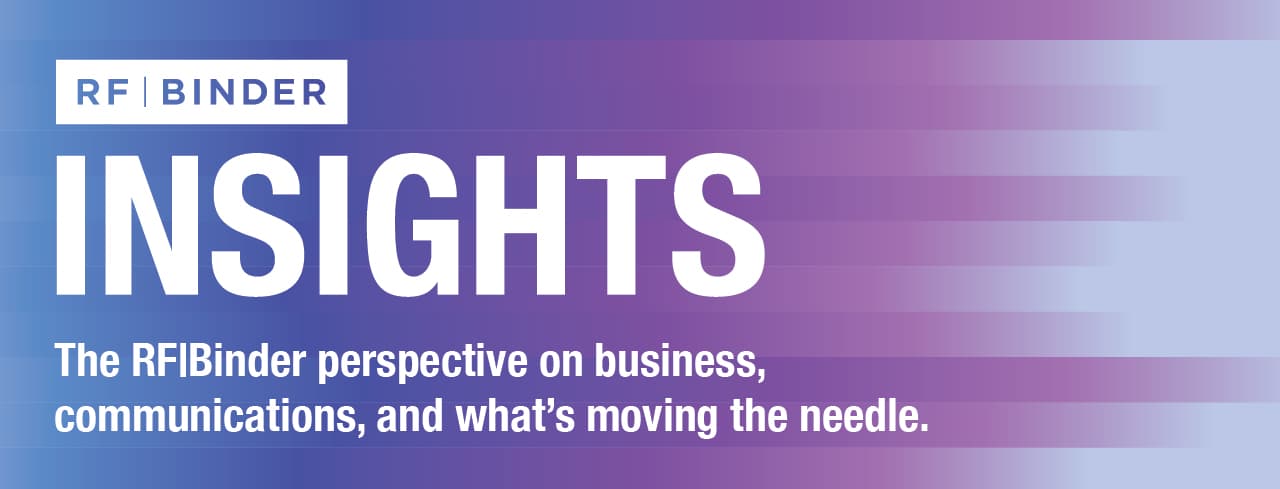In 2023, we introduced the RF|Binder Clarity Lens™ strategic framework. This is a framework that we developed, tested and adapted in various forms over several years, but this year we brought it together in a more formalized manner that reflects our firm’s data-driven approach, ensures alignment between communications and business strategy, and optimizes communications strategies to drive business impact.
As we’ve discussed already, there are three core pillars within the Clarity Lens: Clarity of Impact, Clarity of Language, and Clarity of Connection. Clarity of Impact is the pillar with which we’ve arguably put the firmest stake in the ground – declaring unequivocally that every element of an effective communications strategy must be developed and executed fully in tandem with an organization’s business strategy. This concept is integral to the Clarity Lens framework, and it’s impossible to overstate its importance.
Now, as we approach the end of 2023, we thought it was an opportune time to look back and reflect on one element of “Clarity of Impact” that we haven’t yet written too much about here: namely, the connection between “Impact” and “Purpose.” Because “Clarity of Impact” is more than just aligning your communications strategy and business strategy – it also means meaningfully aligning “what you say” with “what you do.”
Aligning “What You Say” with “What You Do”
“Do what you say” is not a new concept. Communicators have long discussed the importance of “transparency,” “accountability” and “integrity” in serving an organization’s true “purpose.” It’s a concept that is at the core of building trust with key stakeholders. It often comes up in the context of ESG, CSR, and other conversations about companies’ “true impact” on their stakeholders and the world.
But regardless of what we call it, what matters is that the communications and messaging that companies put out must be driven by and reflect the reality of what the company does. This alignment is a critical element in building credibility, fostering trust, and connecting meaningfully with key stakeholders on the issues that matter to them (which has additional connections to our “Clarity of Connection” pillar).
As Alan Murray of Fortune noted just a few weeks ago, even as the term “ESG” has fallen out of vogue, “CEOs insist that defining a purpose beyond profit is more important today than ever.” Even as debates swirl over the right terminology to use, the core concept is not going anywhere: Customers, investors and the general public clearly care about what companies really stand for, and whether companies are “doing what they say.”
“Doing What You Say” in an Age of Greenhushing, Anti-ESG Sentiments, and General Polarization
In 2023, we saw the anti-ESG debate reach a fever pitch. This summer, Larry Fink of BlackRock publicly stated that he will no longer be using the acronym, which he believes has become overly politicized. Other terms and issues have also been called into question, more so here in the U.S. than in the EU. As a consequence, many organizations have become more sensitive about how they talk about their purpose and their impact.
This debate has caused some companies to move toward the practice of “greenhushing” – a play on (and inversion of) “greenwashing,” in which companies are now becoming reluctant to communicate about their sustainability and social impact initiatives for fear of backlash. The backlash could come from either end of the political and activist spectrum: It can come from opponents of the cause at hand, who feel that corporate activism has gone too far, or it can come from extreme advocates of the cause, who feel that a company’s actions on the issue do not go far enough.
Corporate “hushing” in response to criticisms isn’t exclusive to environmental topics: Companies also regularly fall into a “hush” mentality on social topics, such as Target’s backpedaling in response to debates that arose this summer surrounding Pride Month.
But in our perspective, most of these debates miss part or all of the point: Organizations that clearly understand why they do what they do, and can clearly communicate the realities of what they do, have everything to gain by doing so.
To take the BlackRock example: Just because the term “ESG” is falling out of vogue does not mean that impact-oriented work should cease. BlackRock has clearly stated that it is not abandoning its commitment to the concepts behind ESG. For many organizations (BlackRock included), it would seem that the move away from the “ESG” terminology is a thoughtful and effective tactic for sidestepping segments of the conversation that have become overly politicized – enabling them to continue their work to fundamentally address critical issues without being drawn into debates over jargon. We wrote a bit about this in another blog post recently.
Once again, this is a tactical shift that is closely related to another pillar of RF|Binder’s Clarity Lens framework: “Clarity of Connection.” “Clarity of Connection” means ensuring that communications are specifically tailored to meet the needs and expectations of target audiences. This is precisely what BlackRock has done here: By understanding its audience’s expectations, BlackRock was able to adjust its language to help ensure that the true impact of its work resonates as intended.
The Target example is a bit more challenging, but it also cuts to the heart of the matter: Companies should not take on “impact”- or “purpose”-driven positions without carefully evaluating why they are taking those positions, and without establishing exactly how far they are willing to go to stand behind their principles. In Target’s case, it would seem that the company simply had not evaluated how firmly it was willing to stand up for its professed principles, leading to a series of mixed messages and backpedals. For companies positioning themselves as allies or advocates, it’s important to understand that that means taking a side and being ready to stand by it.
What Does It Look Like When a Company Gets It Right? Consider The North Face
Like Bud Light and Target, The North Face drew moderate criticism from conservative groups who took issue with the company’s partnerships and spokespeople during Pride Month – but unlike other companies, The North Face stood by its principles (and its partners) in the face of criticism. Notably, this wasn’t just a one-off decision – it was firmly in line with the brand’s overall identity and congoing commitment to creating a “more inclusive outdoors.”
From the outside, this might look like The North Face was simply standing up for what they felt was morally right, but it is critical to understand that this was also a strategically savvy decision. The North Face was able to act with confidence because it understood where their most important stakeholders – their customers – really stood on the issues at hand, and how they would respond.
The bottom line: Companies that clearly understand what they do, why they do it, and how to effectively communicate it are operating from a position of significant strength.
It’s not just about “integrity” or “authenticity” for the sake of integrity or authenticity – it’s about establishing trust and confidence in your organization and your platform among all of your stakeholders, both external and internal. Companies that achieve full alignment between what they say and what they do are better prepared to defend their business and communications decisions, and they are often more readily able to make strategic shifts in response to new challenges.
Interested in learning more about how the Clarity Lens can sharpen your own organization’s thinking about “purpose”? Reach out to us today.

